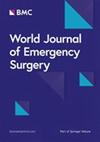奥山德龙治疗烧伤患者:2005年至2025年随机对照试验的系统回顾和最新荟萃分析
IF 5.8
1区 医学
Q1 EMERGENCY MEDICINE
引用次数: 0
摘要
严重烧伤诱导高代谢,导致蛋白质分解代谢,伤口愈合受损,感染风险增加。烧伤患者经常经历雄激素消耗,加剧了这些问题。奥雄龙,一种合成的合成代谢类固醇,已经显示出对抗这些代谢紊乱的希望。这项最新的荟萃分析评估了奥胺龙在烧伤患者中的疗效和安全性,结合了最近的研究、儿科人群、长期结果和联合治疗。这项符合PRISMA 2020标准的系统评价检索了9个数据库(PubMed、Embase、Cochrane、WOS、WHO-ICTRP、CNKI、VIP、万方、CBMdisc),检索了2005年至2025年间发表的随机对照试验,使用了有效的策略,结合了烧伤/创伤和雄激素类似物(如oxandronone、nandronone)的控制词汇(MeSH/Emtree)和自由文本术语。纳入的试验比较了烧伤患者的雄激素类似物与对照组(安慰剂/标准治疗),报告了≥1个预定义结果:(1)瘦体重(恢复阶段,烧伤后≥14天);(2)轻微副作用(肝功能障碍[ALT/AST≥2 × ULN]或水肿);(3)感染;(4)死亡率;(五)外科手术;(6)洛杉矶/回溯;(7)绝对LOS。进行了双独立筛选、数据提取和偏倚风险评估(每个结果的Cochrane RoB 2.0)。随机效应荟萃分析产生了连续结局的标准化平均差异(SMD)和95% ci的二分类结局的风险比(RR)。十四相关(2005 - 2025年;n = 2822例:1203 1619年干预与控制)证明显著减少外科手术(SMD =−1.25;95%可信区间2.45−−0.04;p = 0.04; I2 = 97.2%)和滞留时间规范化回溯(洛杉矶/回溯)(SMD =−1.07;95%可信区间2.43−0.29;p = 0.007; I2 = 98.1%),与增强合成代谢恢复就是增加体重增加(SMD = 0.58; 95%可信区间1.21−2.38;p < 0.001)和精益质量(SMD = 1.30; 95%可信区间0.47−3.24;p < 0.001;i2≥95.0%)。然而,没有观察到死亡率的改善(RR = 1.04; 95% CI 0.47-2.32; p = 0.913; I2 = 66.5%),感染率不变(RR = 0.83; 95% CI 0.67-1.02; p = 0.639),供体部位愈合无改善(SMD = - 1.48; 95% CI - 2.18 - 0.77; p = 0.116)。安全性分析显示治疗相关副作用(肝功能障碍/水肿;RR = 1.82; 95% CI 0.52-6.42; p = 0.34)无显著增加,成人转氨酶升高明显(19% vs 5%安慰剂;p = 0.002)。奥胺龙在烧伤治疗中具有临床应用价值,可显著减轻手术负担(SMD = - 1.25, p = 0.04),缩短住院时间(LOS/TBSA SMD = - 1.07, p = 0.007),促进合成代谢恢复(体重增加SMD = 0.58,瘦质量SMD = 1.30, p均< 0.001)。然而,极端异质性(I2≥95.0%)和时间限制需要谨慎解释。关键的是,它没有死亡率方面的益处(RR = 1.04; p = 0.913),不能减少感染(RR = 0.83; p = 0.639),并增加成人的肝毒性风险(19% vs. 5%; p = 0.002)。这些发现支持其在代谢康复中的辅助作用,但要求风险分层实施。本文章由计算机程序翻译,如有差异,请以英文原文为准。
Oxandrolone for burn patients: a systematic review and updated meta-analysis of randomized controlled trials from 2005 to 2025
Severe burn injuries induce hypermetabolism, leading to protein catabolism, impaired wound healing, and increased infection risk. Burn patients often experience androgen depletion, exacerbating these issues. Oxandrolone, a synthetic anabolic steroid, has shown promise in counteracting these metabolic disturbances. This updated meta-analysis evaluates the efficacy and safety of oxandrolone in burn patients, incorporating recent studies, pediatric populations, long-term outcomes, and combination therapies. This PRISMA 2020-compliant systematic review searched 9 databases (PubMed, Embase, Cochrane, WOS, WHO-ICTRP, CNKI, VIP, Wanfang, CBMdisc) for RCTs published between 2005 and 2025 using validated strategies combining controlled vocabulary (MeSH/Emtree) and free-text terms for burn/trauma AND androgen analogs (e.g., oxandrolone, nandrolone). Included trials compared androgen analogs vs. controls (placebo/standard care) in burn patients, reporting ≥ 1 predefined outcome: (1) Lean body mass (recovery phase, ≥ 14 days post-burn); (2) Mild side effects (hepatic dysfunction [ALT/AST ≥ 2 × ULN] or edema); (3) Infections; (4) Mortality; (5) Surgical procedures; (6) LOS/TBSA; (7) Absolute LOS. Dual-independent screening, data extraction, and risk-of-bias assessment (Cochrane RoB 2.0 per outcome) were performed. Random-effects meta-analyses generated standardized mean differences (SMD) for continuous outcomes and risk ratios (RR) for dichotomous outcomes with 95% CIs. Fourteen RCTs (2005–2025; n = 2822 patients: 1203 intervention vs. 1619 controls) demonstrated significant reductions in surgical procedures (SMD = − 1.25; 95% CI − 2.45 to − 0.04; p = 0.04; I2 = 97.2%) and length of stay normalized to TBSA (LOS/TBSA) (SMD = − 1.07; 95% CI − 2.43 to 0.29; p = 0.007; I2 = 98.1%), alongside enhanced anabolic recovery evidenced by increased weight gain (SMD = 0.58; 95% CI − 1.21 to 2.38; p < 0.001) and lean mass (SMD = 1.30; 95% CI − 0.47 to 3.24; p < 0.001; I2 ≥ 95.0%). However, no mortality benefit was observed (RR = 1.04; 95% CI 0.47–2.32; p = 0.913; I2 = 66.5%), with unchanged infection rates (RR = 0.83; 95% CI 0.67–1.02; p = 0.639) and no improvement in donor site healing (SMD = − 1.48; 95% CI − 2.18 to 0.77; p = 0.116). Safety analysis revealed a non-significant increase in treatment-related side effects (hepatic dysfunction/edema; RR = 1.82; 95% CI 0.52–6.42; p = 0.34), notably higher transaminase elevations in adults (19% vs. 5% placebo; p = 0.002). Oxandrolone demonstrates clinical utility in burn management by significantly reducing surgical burden (SMD = − 1.25; p = 0.04), shortening hospitalization (LOS/TBSA SMD = − 1.07; p = 0.007), and enhancing anabolic recovery (weight gain SMD = 0.58; lean mass SMD = 1.30; both p < 0.001). However, extreme heterogeneity (I2 ≥ 95.0%) and temporal limitations necessitate cautious interpretation. Critically, it confers no mortality benefit (RR = 1.04; p = 0.913), fails to reduce infections (RR = 0.83; p = 0.639), and elevates hepatotoxicity risk in adults (19% vs. 5%; p = 0.002). These findings support its adjunctive role in metabolic rehabilitation but mandate risk-stratified implementation.
求助全文
通过发布文献求助,成功后即可免费获取论文全文。
去求助
来源期刊

World Journal of Emergency Surgery
EMERGENCY MEDICINE-SURGERY
CiteScore
14.50
自引率
5.00%
发文量
60
审稿时长
10 weeks
期刊介绍:
The World Journal of Emergency Surgery is an open access, peer-reviewed journal covering all facets of clinical and basic research in traumatic and non-traumatic emergency surgery and related fields. Topics include emergency surgery, acute care surgery, trauma surgery, intensive care, trauma management, and resuscitation, among others.
 求助内容:
求助内容: 应助结果提醒方式:
应助结果提醒方式:


